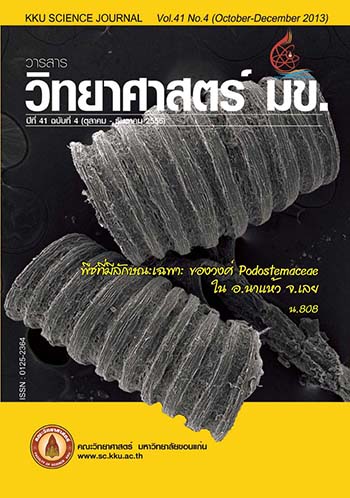Screening of Cellulolytic Microorganisms for Stimulating of Rice (Oryza sativa L.) and Sweet Corn (Zea mays L. var. saccharata) Seed Germination
Main Article Content
Abstract
Isolation of cellulolytic microorganisms from soil, filter cake and distillery samples was made. The isolated cellulolytic microorganisms were studied for the stimulating of seed germination. It was found that 26 isolates of bacteria, 4 isolates of actinomycetes and one isolate of fungus degraded carboxy methyl cellulose on CMC agar. The hydrolysis of carboxy methyl cellulose (CMC) was tested on the agar plate. The highest hydrolysis capacity (HC value) was found in isolates ACSI (2.5), BDS31 (2.25), BFC8 (2.0) and FFC2 (1.02) respectively. The isolates of bacteria, actinomycetes and fungus were detected for filter paper activity for cellulase. Cellulase activity in bacterial isolates BDS31 and BFC8, actinomycetal isolate ACSI and fungal isolate FFC2 were 0.37, 0.36, 0.5and 0.16 unit/ml, respectively. Cellulolytic microorganisms isolate ACSI, BDS31, BFC 8 and FFC2 were used to stimulate the germination of seeds of rice variety Phitsanulok 2 (Oryza sativa L.) and sweet corn (Zea mays saccharata) variety wanburi. The highest germination index value (GI) of rice root was 127.13 % when inoculated with bacteria isolate BDS31. Whereas, fungal isolate FFC2 could stimulate (GI 86.97%) the germination of sweet corn root. 4 isolates of the cellulolytic microorganisms were studied on morphology under the compound microscope together with the analysis of DNA sequencing. The isolate of BFC8 was gram negative bacteria, rod shape and streptobacilli. Isolate BDS31 was gram positive bacteria, rod shape, endospore forming and brow color of colony. Isolate ACSI has straight spore chain, yellow color of colony and gray color of spore and isolate FFC2 was black spore and
white hypha color. The data of DNA sequencing were identified as Cronobacter sakazakii (100 % similarity), Bacillus licheniformis (98 % similarity), Streptomyces thermodiastaticus (100 % similarity) and Thermomyces lanuginosus (100 % similarity) respectively.
Article Details

This work is licensed under a Creative Commons Attribution-NonCommercial-NoDerivatives 4.0 International License.


